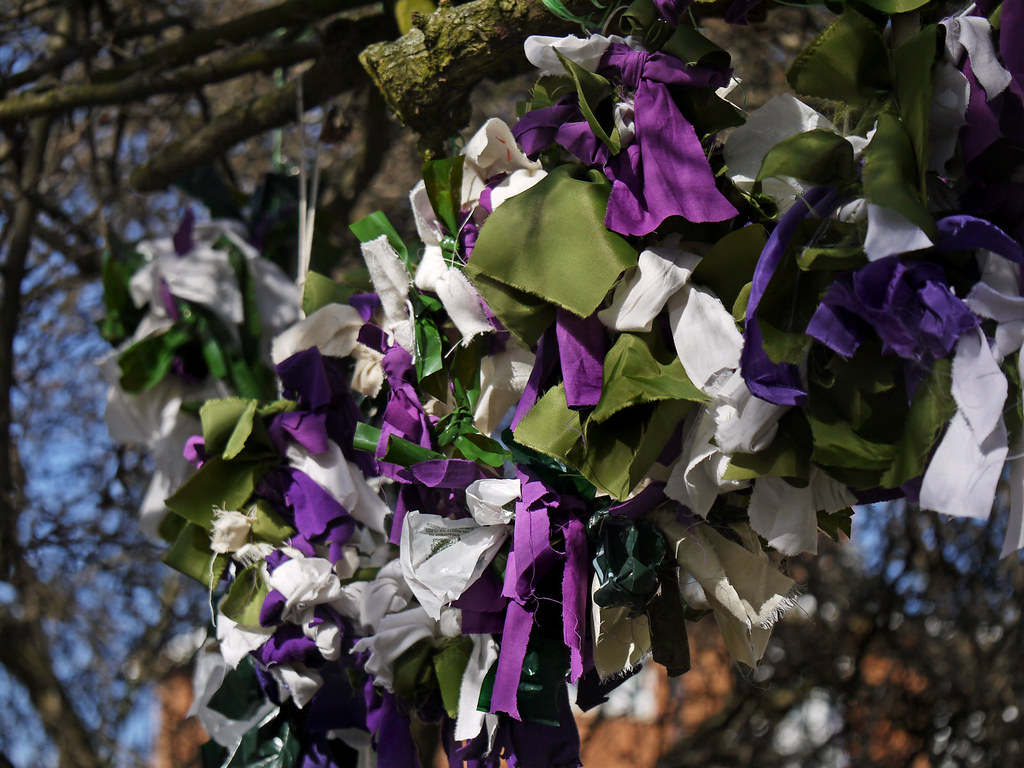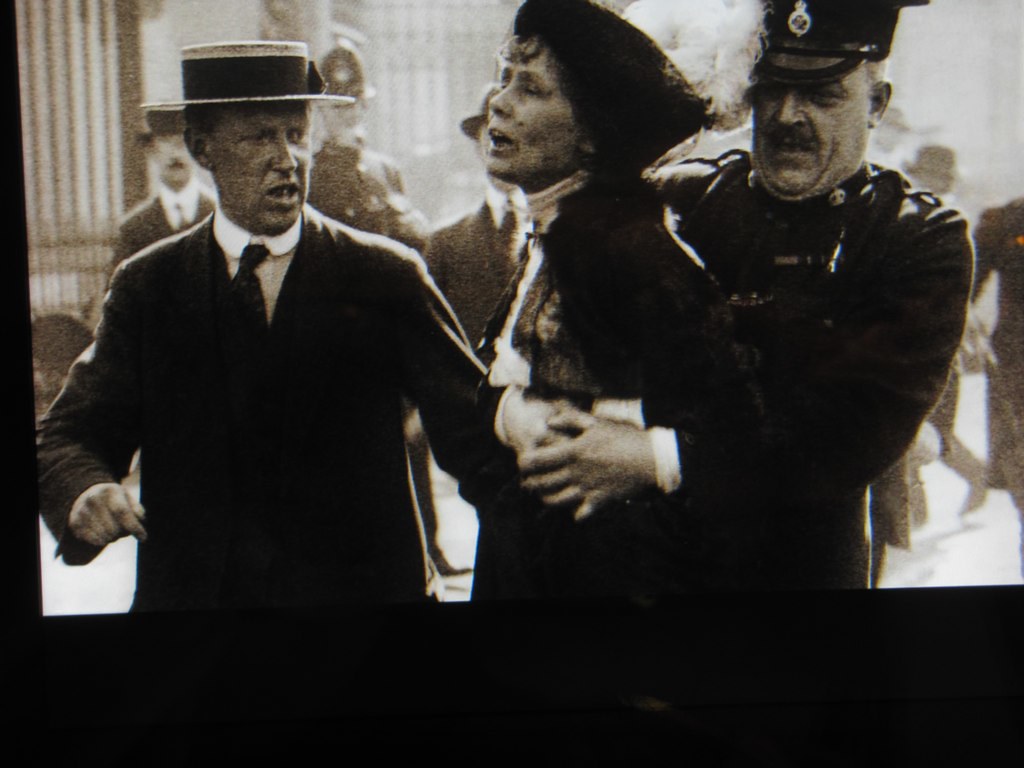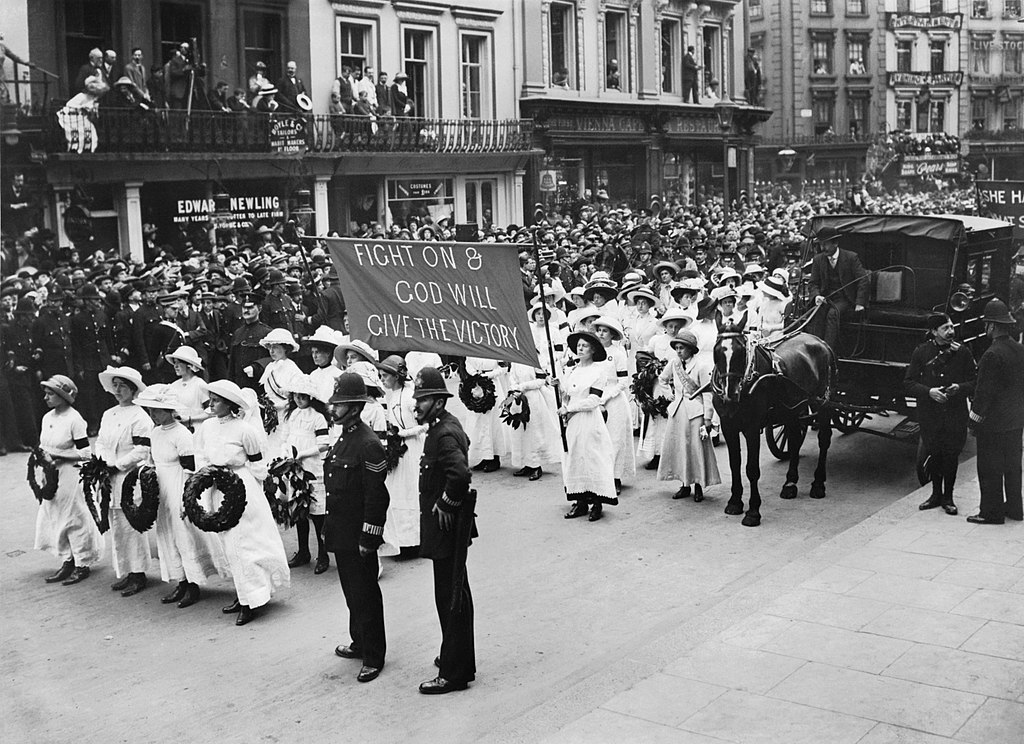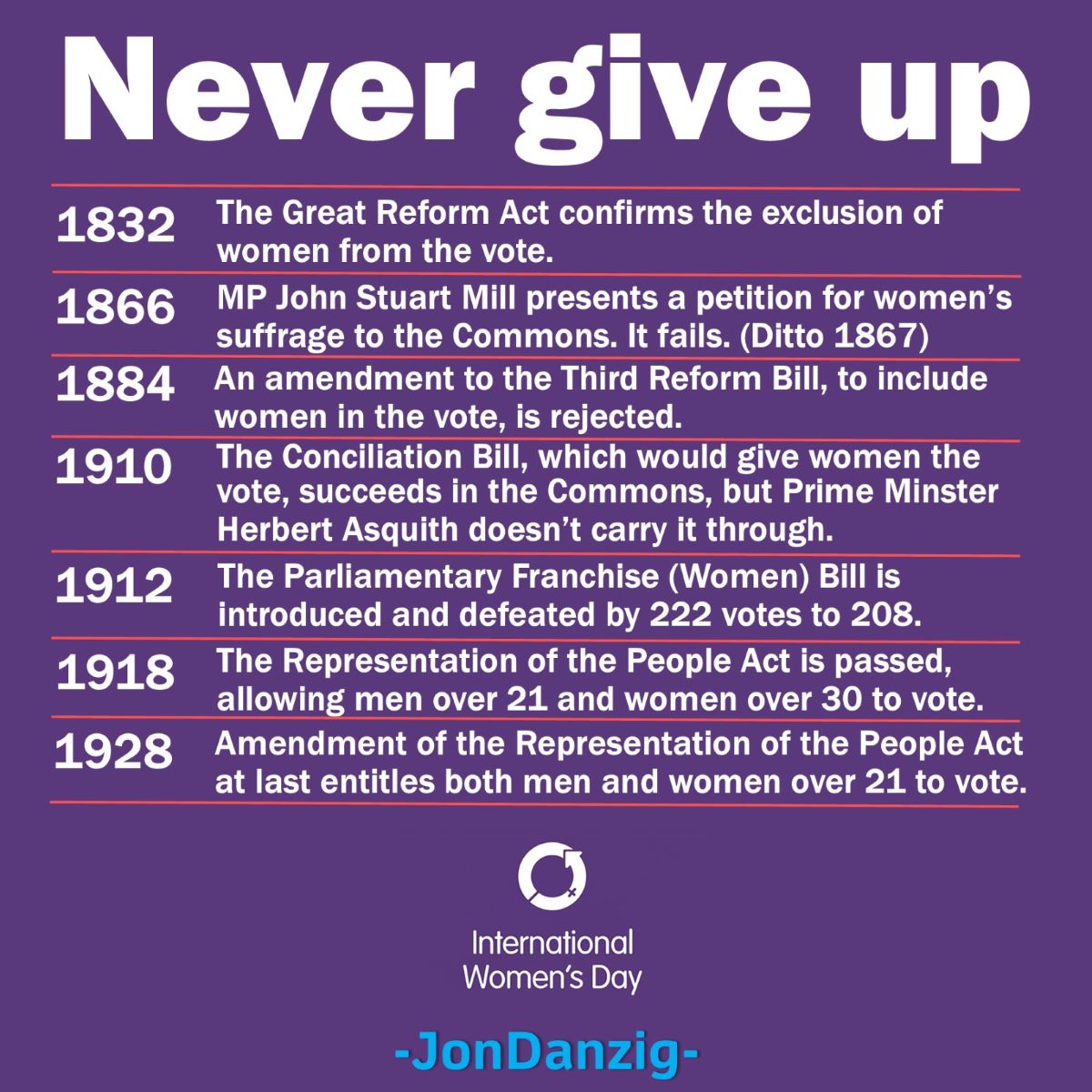
𝗪𝗢𝗠𝗘𝗡 𝗞𝗘𝗣𝗧 𝗟𝗢𝗦𝗜𝗡𝗚 𝗕𝗘𝗙𝗢𝗥𝗘 𝗪𝗜𝗡𝗡𝗜𝗡𝗚 𝗧𝗛𝗘 𝗥𝗜𝗚𝗛𝗧 𝗧𝗢 𝗩𝗢𝗧𝗘, Jon Danzig reminds us.
Today – 8 March – is International Women’s Day, which for more than 100 years has celebrated the economic, cultural, political, and social achievements of women across the world.
And 100 years is about how long it took women in the United Kingdom to win the right to vote.
Women (and men who supported them) campaigned for our Parliament to give them the vote, but time and again, Parliament refused.
But those brave and determined women – known as suffragettes – didn’t give up.
Even after losing vote after vote to win the right to vote, they carried on campaigning.
Eventually they won, when in 1918 Parliament passed the Representation of the People Act, which for the first time gave women over the age of 30 the right to vote (but only if their husbands were property owners).
Well, even though that was a democratic decision of Parliament, those women didn’t accept it. They carried on protesting to win full and equal voting rights with men.
In the UK, all women aged over 21 eventually got the vote on 2 July 1928 – but only after many decades of campaigning.
Of course, it was not easy going. It wasn’t just Parliament that was against women having the vote.
During the early 20th century there was widespread public support for what was known as ‘anti-suffragism’.
As reported in an historical account by the British Library:
‘The campaign for the (women’s) vote was a long one, most obviously because of resistance by male politicians but also because public support for the female franchise was far from overwhelming.’
By 1914 the National League for Opposing Women’s Suffrage had 42,000 paid-up members and thousands more non-paying supporters.
Its members – both men and women – collected over half a million signatures for petitions against votes for women, and its leaders were confidently demanding a national referendum on the issue.
You can just imagine those ‘antis’ shouting at marching suffragettes:
‘GIVE UP! YOU LOST!’
Doesn’t that seem familiar?
For years following the referendum, Brexiters have been telling Remainers that they must ‘give up’ because they lost.
But those Brexiters forgot that losing a vote didn’t stop THEM from campaigning for a new vote with a different outcome.
Yes, that’s exactly what happened after Brexiters – then called Eurosceptics – lost the first in/out referendum in 1975, and again, when they lost the General Election in 1983, when Labour promised Britain’s departure from the European Community.
Brexiters lost. But they carried on campaigning.
Just as women who lost carried on campaigning.
And just as Remainers, now Rejoiners, who lost are carrying on campaigning.
Women didn’t give up. Brexiters didn’t give up. And Rejoiners won’t give up.
In a democracy, no vote is set in stone.
In a democracy, any vote can be reversed by a new vote. In a democracy, voters are allowed new opportunities to express a change of mind.
If women had given up every time they lost, they would never have got the vote.
Losing a vote is never a reason to stop campaigning for what you believe in.
Or as the American civil rights advocate, William H. Hastie said:
‘Democracy is a process, not a static condition.’

Just look at the long ‘democratic process’ that women had to endure to win suffrage in Britain:
▪ 1832 – Mary Smith presents the first petition for women’s suffrage to Parliament. But in the same year, the Great Reform Act confirms the exclusion of women from the vote.
▪ 1866 – The MP John Stuart Mill presents a petition for women’s suffrage to the Commons. It fails. Consequently, suffrage societies are started in Edinburgh, London, and Manchester.
▪ 1867 – A Second Reform Bill petition from women is presented to Parliament by John Stuart Mill but it fails. The National Society for Women’s Suffrage is formed.
▪ 1881 – The Isle of Man grants votes to women.
▪ 1884 – An amendment to the Third Reform Bill, to include women in the vote, is rejected.
▪ 1897 – The National Union of Women’s Suffrage Societies (NUWSS) is established, with over 20 societies across the country.
▪ 1903 – Emmeline Pankhurst, frustrated by the slow tactics of the NUWSS, forms the Women’s Social and Political Union (WSPU) with her daughters Sylvia and Christabel.
▪ 1905 – Militant campaigning begins. Christabel Pankhurst and Annie Kenney are arrested and imprisoned. “Deeds, not words” and “Votes for women” are the new campaign slogans.
▪ 1906 – The Liberal Prime Minister, Sir Henry Campbell-Bannerman, and 400 of 670 MPs are in favour of women’s suffrage. WSPU members are arrested and imprisoned. A daily newspaper coins the term “suffragette”.
▪ 1907 – The NUWSS organises a London march and more than 3,000 women take part. The WFL starts a paper called The Vote.
▪ 1908 – Around half a million suffragette activists attend a mass rally in Hyde Park. But the Liberal Prime Minister Herbert Asquith does not respond. So the protestors smash windows in Downing Street, using stones with written messages tied to them. Some protesters chain themselves to the railings.
▪ 1909 – The start of hunger strikes and forced-feeding. Scottish WSPU member Marion Wallace Dunlop becomes the first hunger striker. More and more militant WSPU members are imprisoned.
▪ 1910 – The Conciliation Bill, which would give women the vote, succeeds in the Commons but Prime Minster, Herbert Asquith, doesn’t carry it through.
The WSPU starts protests, including those called ‘Black Friday’ in which many women are hurt, some permanently and later fatally. There are allegations against the police of sexual abuse whilst women are in custody.
▪ 1911 – A new Conciliation Bill that would give women the vote passes, but is stalled by the general election.
▪ 1912 – The Parliamentary Franchise (Women) Bill is introduced and defeated by 222 votes to 208. In protest, there is a mass window-smashing campaign.
▪ 1913 – A ruling by the Commons Speaker destroys hopes of an amendment to include women in the Reform Bill. There are bomb and arson campaigns.
More arrests lead to the passing of the “Cat and Mouse” Act, under which hunger strikers are temporarily released but then rearrested to prevent them from dying in police custody.
Also in this year, Emily Wilding Davison was arrested nine times and force-fed 49 times. She decides to draw attention to the suffrage cause and disrupt the Derby by stepping in front of the King’s horse Anmer.
Emily dies four days later of a skull fracture and other injuries. Her funeral is attended by thousands of women. Tens of thousands lined the streets of London as her coffin passed by.

▪ 1914 – Violent protests escalate. Suffragettes try to force their way into Buckingham Palace to petition the King.
▪ 1917 – The Electoral Reform Bill passes in the Commons. It gives votes to certain women only: those aged over 30, and those over 21 who own their own house or those married to householders.
▪ 1918 – The Representation of the People Act is passed, allowing men over 21 and women over 30 to vote.
▪ 1919 – The first female MP, Nancy Astor, enters the Commons.
▪ 1928 – Amendment of the Representation of the People Act entitles everyone over the age of 21 – men and women – to vote.

Women lost vote after vote to get the vote. But they didn’t give up.
Remainers (now Rejoiners) lost the 2016 referendum, and the 2017 and 2019 general elections. But we won’t give up.
𝗝𝗼𝗻 𝗗𝗮𝗻𝘇𝗶𝗴 is an independent campaigning journalist and film maker who specialises in writing about health, human rights, and Europe. He is also founder of the information campaign, Reasons2Rejoin.





